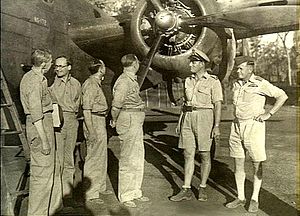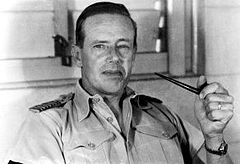- No. 79 Wing RAAF
-
No. 79 Wing RAAF 
Commanders of No. 18 (NEI) Squadron and No. 79 Wing: Lieutenant Colonel Asjes (second right) and Group Captain Ryland (far right) at Batchelor, Northern Territory, 1944Active 1943–1945 Country  Australia
AustraliaBranch  Royal Australian Air Force
Royal Australian Air ForceRole Attack Size Two–four flying squadrons Part of North Western Area (1943–44)
Northern Command (1944–45)
First Tactical Air Force (1945)Engagements World War II Commanders Notable
commandersCharles Eaton Aircraft flown Attack Beaufort Bomber B-25 Mitchell Fighter Beaufighter No. 79 Wing was a Royal Australian Air Force (RAAF) wing of World War II. It was formed in December 1943 at Batchelor, Northern Territory, as part of North Western Area Command. Led by Group Captain Charles Eaton, the wing comprised four squadrons on its establishment, flying Beaufort and B-25 Mitchell bombers and Beaufighter heavy fighters. No. 79 Wing took part in the New Guinea and North Western Area Campaigns during 1944, transferring to bases in New Guinea and later Morotai as the Allies advanced northward. By the end of the Pacific War, the wing was attached to the Australian First Tactical Air Force and was made up of Nos. 2 and 18 (Netherlands East Indies) Squadrons, both flying Mitchells. The latter transferred to the Netherlands Air Force in late 1945, while the former returned to Australia where it disbanded the following year.
History
No. 79 Wing was established at Batchelor, Northern Territory, on 30 November 1943. Its combat units included No. 1 and No. 2 Squadrons (flying Beaufort light reconnaissance bombers), No. 31 Squadron (Beaufighter long-range fighters), and No. 18 (Netherlands East Indies) Squadron (B-25 Mitchell medium bombers). The wing was commanded by Group Captain Charles Eaton, whose Dutch personnel nicknamed him "Oom Charles" (Uncle Charles).[1][2]
Operating under the auspices of North Western Area Command (NWA), Darwin, No. 79 Wing participated in the New Guinea and North Western Area Campaigns during 1944.[2] Through March–April, the Beaufighters attacked enemy shipping, while the Mitchells and Beauforts bombed Timor on a daily basis as a prelude to Operations Reckless and Persecution, the invasions of Hollandia and Aitape. On 19 April, Eaton organised a large raid against Su, Dutch Timor, employing thirty-five Mitchells, Beauforts and Beaufighters to destroy the town's barracks and fuel dumps, the results earning the personal congratulations of the Air Officer Commanding NWA, Air Vice Marshal "King" Cole.[2][3] On the day of the Allied landings, 22 April, the Mitchells and Beaufighters made a daylight raid on Dili, Portuguese Timor. The ground assault met little opposition, credited in part to the air bombardment in the days leading up to it.[2]
In May 1944, Nos. 1, 18 and 31 Squadrons attacked enemy positions in Timor, while No. 2 Squadron was withdrawn from combat to re-equip with Mitchells. No. 79 Wing's light and medium bombers suffered from a lack of suitable targets as they had few airfields in forward areas from which to refuel. No. 2 Squadron returned to operations with Mitchells in June. That month, No. 18 Squadron flew 149 sorties, damaging Japanese airfields and shipping in the Timor area, but lost its commanding officer to anti-aircraft fire during a raid.[4] In June–July, No. 79 Wing supported the Allied attack on Noemfoor. No. 18 Squadron was again the wing's most active unit, flying 107 sorties. In September, the Beaufighters and Mitchells attacked Japanese shipping and infrastructure in Ceram and Celebes, but lost nine aircraft and twenty-six crewmen killed. By the end of month, Mitchell missions were put on hold while replacement crews were trained.[5] In late 1944, the decision was made to transfer No. 79 Wing and its Mitchell squadrons from North Western Area Command to Northern Command (formerly No. 9 Operational Group) in Papua New Guinea, to undertake operations against the Japanese in New Britain. No. 31 Squadron was transferred from No. 79 Wing to the Australian First Tactical Air Force at Morotai in December.[6][7] The same month, Group Captain Eaton posted out and was replaced by Group Captain John Ryland.[8]
Weather hampered the wing's activities in January 1945. No. 1 Squadron was withdrawn to Queensland to re-equip with Mosquitos, with No. 13 Squadron, flying Venturas, taking up the slack on anti-shipping missions. The squadron accounted for around half of the thirty-eight enemy vessels sunk by No. 79 Wing in February, and a similar ratio to the twenty sunk the following month. On 6 April, all twenty available Mitchells of Nos. 2 and 18 Squadrons joined B-24 Liberators of No. 82 Wing in an assault on a Japanese convoy that included the cruiser Isuzu; the Mitchells claimed two direct hits without loss, despite anti-aircraft fire from the cruiser and other ships, and frontal attacks by enemy fighters.[9] Allied submarines sank the damaged Isuzu the following day.[10] In July, following the Battle of North Borneo, No. 79 Wing and its remaining squadrons, Nos. 2 and 18, were transferred to the First Tactical Air Force at Labuan.[11] The wing's final recorded action was repatriating RAAF personnel from the islands of Borneo to Australia, following the end of the Pacific War in August 1945.[12] No. 18 Squadron was reassigned to the Netherlands Air Force in November 1945;[10] the next month No. 2 Squadron returned to Australia, where it disbanded in mid-1946.[13]
Notes
- ^ Farram, Charles "Moth" Eaton, p. 38
- ^ a b c d Odgers, Air War Against Japan, pp. 215–218
- ^ Farram, Charles "Moth" Eaton, pp. 48–49
- ^ Odgers, Air War Against Japan, pp. 228–233
- ^ Odgers, Air War Against Japan, pp. 243–247
- ^ Odgers, Air War Against Japan, pp. 297–299
- ^ Odgers, Air War Against Japan, p. 379
- ^ Ryland, John Peter (1911 – 1973) at Australian Dictionary of Biography. Retrieved on 18 November 2010.
- ^ Odgers, Air War Against Japan, pp. 402–407
- ^ a b 18 (NEI) Squadron RAAF at Australian War Memorial. Retrieved on 12 November 2010.
- ^ Odgers, Air War Against Japan, p. 476
- ^ Odgers, Air War Against Japan, p. 495
- ^ 2 Squadron RAAF at Australian War Memorial. Retrieved on 11 November 2010.
References
- Farram, Steven (2007). Charles "Moth" Eaton: Pioneer Aviator of the Northern Territory. Darwin: Charles Darwin University Press. ISBN 978-0-9803846-1-1. OCLC 212893829.
- Odgers, George (1968) [1957]. Australia in the War of 1939–1945: Series Three (Air) Volume II – Air War Against Japan 1943–45. Canberra: Australian War Memorial. http://www.awm.gov.au/histories/chapter.asp?volume=27.
Categories:- RAAF wings
Wikimedia Foundation. 2010.


